Mallabhum kingdom | |
|---|---|
| 694–1947 CE | |
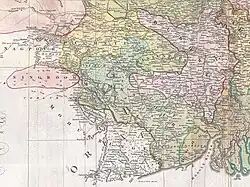 Bishnupur on James Rennell's Mid-18th Century map. | |
| Capital | Laugram Pradyumnapur Bishnupur |
| Common languages | Sanskrit Bengali |
| Religion | Hinduism |
| Government | Monarchy |
| Maharaja | |
• 694–710 CE | Adi Malla |
• 1930–1983 CE | Kalipada Singha Thakur |
| Historical era | Classical India Medieval India Early Modern Period |
• Established | 694 |
• Disestablished | 29 December 1947 CE |
Mallabhum (The Country originally known as Mallabhoom or Mallabani[1] Bengali: মল্লভূম or Bishnupur kingdom[2] ) was the kingdom ruled by the Malla kings of Bishnupur, primarily in the present Bankura district in Indian state of West Bengal.
History
Territory of the Mallabhum
Mallabhum was a territory which included Bankura, a part of Burdwan, Birbhum, Santhal Parganas, Midnapur and also a part of Purulia. The Malla Rajas ruled over the vast territory in the south-western part of present West Bengal and a part of southeastern Jharkhand.[3]
Extent
From around 7th century CE until the advent of British rule, the history of Bankura district is identical with the rise and fall of the Hindu Rajas of Bishnupur.
Administration
According to Bhattacharjee, Tarun Dev (1982) during Malla period, the society was centred round the village. The tax collectors were called as Gumasta and their assistants as Aat Pahari or Paik. The Mukhiya or Mandal was the title of headman, who was regarded as the guardian of the village. Malla kings had several service groups. Due to scarcity of money, the Malla kings used to present land instead of salary to all these service groups. This type of land is again of two types – namely the Panchaki jamin or land with a little tax and another one is the Bepanchaki jamin or land without any tax. Again the lands were named as per the service groups name as Senapati mahal for the head of the soldier, land given to the sentry was Mahalbera Mahal, and land given to the bodyguard was Chharidar Mahal.[4]
Malla rulers
Malla's started their own calendar that is Malla era (Mallabda). It is told that Malla era started from Indra Dwadasi day in the year 102 Bengali calendar of the month Bhadro (August- September).[5]
| Sl. No. | Name of the king[6] | Gregorian calendar | Bengali calendar | Malla calendar | Reign (year) |
|---|---|---|---|---|---|
| 1 | Adi Malla | 694 | 102 | 1 | 16 |
| 2 | Jay Malla | 710 | 117 | 16 | 10 |
| 3 | Benu Malla | 720 | 127 | 26 | 13 |
| 4 | Kinu Malla | 733 | 140 | 39 | 9 |
| 5 | Indra Malla | 742 | 149 | 48 | 15 |
| 6 | Kanu Malla | 757 | 164 | 63 | 7 |
| 7 | Dha Malla (Jhau) | 764 | 171 | 70 | 11 |
| 8 | Shur Malla | 775 | 182 | 81 | 20 |
| 9 | Kanak Malla | 795 | 202 | 101 | 12 |
| 10 | Kandarpa Malla | 807 | 214 | 113 | 21 |
| 11 | Sanatan Malla | 828 | 235 | 134 | 13 |
| 12 | Kharga Malla | 841 | 248 | 147 | 21 |
| 13 | Durjan Malla (Durjay) | 862 | 269 | 168 | 44 |
| 14 | Yadav Malla | 906 | 313 | 212 | 13 |
| 15 | Jagannath Malla | 919 | 326 | 225 | 12 |
| 16 | Birat Malla | 931 | 338 | 237 | 15 |
| 17 | Mahadev Malla | 946 | 353 | 252 | 31 |
| 18 | Durgadas Malla | 977 | 384 | 283 | 17 |
| 19 | Jagat Malla | 994 | 401 | 300 | 13 |
| 20 | Ananta Malla | 1007 | 414 | 313 | 8 |
| 21 | Rup Malla | 1015 | 422 | 321 | 14 |
| 22 | Sundar Malla | 1029 | 436 | 335 | 24 |
| 23 | Kumud Malla | 1053 | 460 | 359 | 21 |
| 24 | Krishna Malla | 1074 | 481 | 380 | 10 |
| 25 | Rup Malla II (Jhap) | 1084 | 491 | 390 | 13 |
| 26 | Prakash Malla | 1097 | 504 | 403 | 5 |
| 27 | Pratap Malla | 1102 | 509 | 408 | 11 |
| 28 | Sindur Malla | 1113 | 520 | 419 | 16 |
| 29 | Sukhomoy Malla (Shuk) | 1129 | 536 | 435 | 13 |
| 30 | Banamali Malla | 1142 | 549 | 448 | 14 |
| 31 | Yadu/Jadu Malla | 1156 | 563 | 462 | 11 |
| 32 | Jiban Malla | 1167 | 574 | 473 | 13 |
| 33 | Ram Malla | 1185 | 592 | 491 | 24 |
| 34 | Gobinda Malla | 1209 | 616 | 515 | 31 |
| 35 | Bhim Malla | 1240 | 647 | 546 | 23 |
| 36 | Katar Malla (Kattar/Khattar) | 1263 | 670 | 569 | 32 |
| 37 | Prithwi Malla | 1295 | 702 | 601 | 24 |
| 38 | Tapa Malla | 1319 | 726 | 625 | 15 |
| 39 | Dinabandhu Malla | 1334 | 741 | 640 | 11 |
| 40 | Kinu/Kanu II Malla | 1345 | 752 | 651 | 13 |
| 41 | Shur Malla II | 1358 | 765 | 664 | 12 |
| 42 | Shiv Singh Malla | 1370 | 777 | 676 | 37 |
| 43 | Madan Malla | 1407 | 814 | 713 | 13 |
| 44 | Durjan Malla II (Durjay) | 1420 | 827 | 726 | 17 |
| 45 | Uday Malla | 1437 | 844 | 743 | 23 |
| 46 | Chandra Malla | 1460 | 867 | 766 | 41 |
| 47 | Bir Malla | 1501 | 908 | 807 | 53 |
| 48 | Dhari Malla | 1554 | 961 | 860 | 11 |
| 49 | Hambir Malla Dev (Bir Hambir) | 1565 | 972 | 871 | 55 |
| 50 | Dhari Hambir Malla Dev | 1620 | 1027 | 926 | 6 |
| 51 | Raghunath Singha Dev | 1626 | 1033 | 932 | 30 |
| 52 | Bir Singha Dev | 1656 | 1063 | 962 | 26 |
| 53 | Durjan Singha Dev | 1682 | 1089 | 988 | 20 |
| 54 | Raghunath Singha Dev II | 1702 | 1109 | 1008 | 10 |
| 55 | Gopal Singha Dev | 1712 | 1119 | 1018 | 36 |
| 56 | Chaitanya Singha Dev | 1748 | 1155 | 1054 | 53 |
| 57 | Madhav Singha Dev | 1801 | 1208 | 1107 | 8 |
| 58 | Gopal Singha Dev II | 1809 | 1216 | 1115 | 67 |
| 59 | Ramkrishna Singha Dev | 1876 | 1283 | 1182 | 9 |
| Dwhaja Moni Devi | 1885 | 1292 | 1191 | 4 | |
| 60 | Nilmoni Singha Dev | 1889 | 1296 | 1195 | 14 |
| Churamoni Devi (Regency) | 1903 | 1310 | 1209 | 14 | |
| 61 | Kalipada Singha Thakur | 1930–1983 | 1337 – 1390 | 1236–1289 | 53 |
Temples
According to Dr. Bloch, Superintendent of the Archaeological Survey of India, Eastern Circle, the twelve date temples range in chronological order as follows:[7]
| Date in
Malla year |
Date C.E. | Name of temple | By Whom built |
|---|---|---|---|
| 928 | 1622 | Malleswar | Bir Singha, son of Raghunath Singha |
| 949 | 1643 | Syam Rai | Raghunath Singha, son of Bir Hambir. |
| 961 | 1655 | Jor Bangla | |
| 962 | 1656 | Kala Chand | |
| 964 | 1658 | Lalji | Bir Singha |
| 971 | 1665 | Madan Gopal | Siromani, wife of Bir Singha |
| 971 | 1665 | Murali Mohan | Siromoni Devi, wife of Bir Singha (Called Churamoni in the Inscription) |
| 1000 | 1694 | Madan Mohan | Durjan Singha |
| 1032 | 1726 | Jor Mandir | Gopal Singha |
| 1035 | 1729 | Radha Gobind | Krishna Singha, son of Gopal Singha |
| 1043 | 1737 | Radha Madhab | Churamoni, wife of Gopal Singha |
| 1064
(Saka 1680) |
1758 | Radha Syam | Chaitanya Singha |
Gallery
| History of South Asia |
|---|
_without_national_boundaries.svg.png.webp) |
 Rasmancha (1600 CE)
Rasmancha (1600 CE)_Arnab_Dutta_2011.JPG.webp) Rasmancha (1600 CE)
Rasmancha (1600 CE) Jor Mandir (1726 CE)
Jor Mandir (1726 CE)_Arnab_Dutta_2011.JPG.webp) Radhamadhab Temple (1737 CE)
Radhamadhab Temple (1737 CE)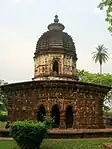 Kalachand Temple (1656 CE)
Kalachand Temple (1656 CE)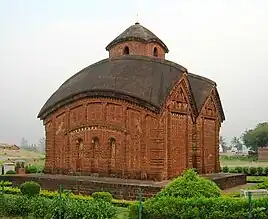 Jor-Bangla Temple or Keshta Roy Temple (1655 CE)
Jor-Bangla Temple or Keshta Roy Temple (1655 CE) Jor Mandir complex (1726 CE)
Jor Mandir complex (1726 CE)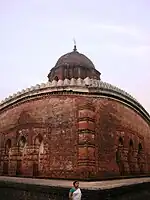 Madan Mohan Temple (1694 CE)
Madan Mohan Temple (1694 CE)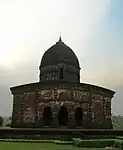 Radha-Gobinda Temple (1729 CE)
Radha-Gobinda Temple (1729 CE)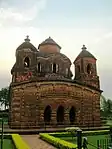 Shyam Ray Temple (1643 CE)
Shyam Ray Temple (1643 CE) Bishnpur fort gate
Bishnpur fort gate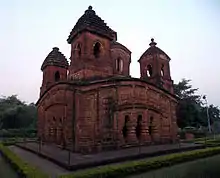 Panchchura temple
Panchchura temple Stone chariot of Bishnupur
Stone chariot of Bishnupur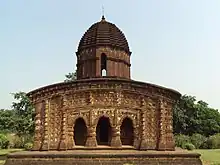 Nandalal Temple
Nandalal Temple Rashmancha (gate)
Rashmancha (gate)_Arnab_Dutta_2011.JPG.webp) Jor Bangla Temple (arches)
Jor Bangla Temple (arches) Jor Bangla temple (Terracotta work)
Jor Bangla temple (Terracotta work)_Arnab_Dutta_2011.JPG.webp) Jor Bangla Temple (Ramayana motifs)
Jor Bangla Temple (Ramayana motifs) Shyamrai Temple (Terracotta work)
Shyamrai Temple (Terracotta work) Shyamrai Temple (RasChakra)
Shyamrai Temple (RasChakra)
References
- ↑ Steemers, Koen (2000). Architecture, City, Environment: Proceedings of PLEA 2000 : July 2000 ... James & James (Science Publishers) Ltd. p. 377. ISBN 1902916166.
- ↑ "Bishnupur". Britannica.
Mallabhum kingdom
- ↑ Dasgupta, Biswas & Mallik 2009, p. 12.
- ↑ Dasgupta, Biswas & Mallik 2009, p. 19-20.
- ↑ Dasgupta, Biswas & Mallik 2009, p. 19.
- ↑ Dasgupta, Biswas & Mallik 2009, p. 31-43.
- ↑ "Bankura Gazetteer CHAPTER XIV" (PDF). bankura.gov.in. Government of West Bengal. p. 185. Retrieved 2 February 2016.
Sources
- Dasgupta, Samira; Biswas, Rabiranjan; Mallik, Gautam Kumar (2009), Heritage Tourism: An Anthropological Journey to Bishnupur, Mittal Publications, ISBN 978-81-8324-294-3